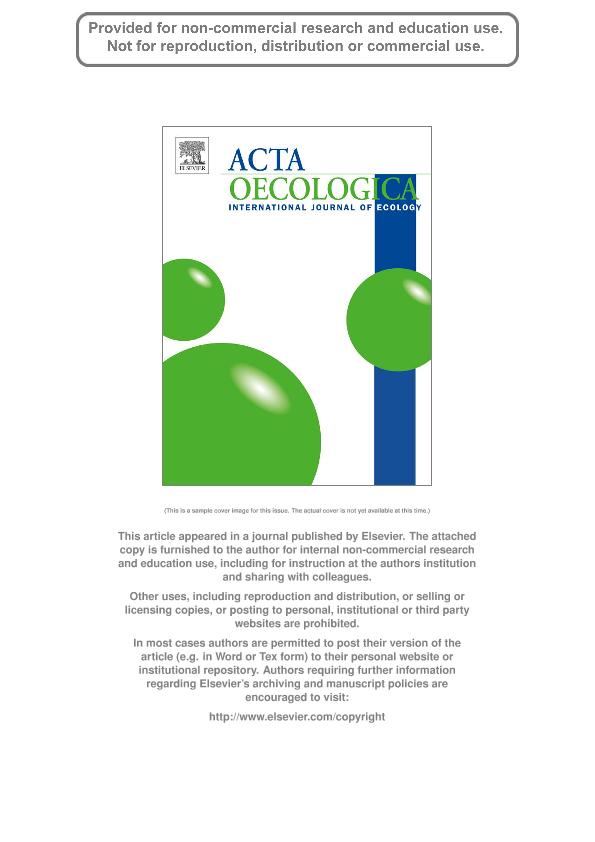Mostrar el registro sencillo del ítem
dc.contributor.author
Astegiano, Julia

dc.contributor.author
Funes, Guillermo

dc.contributor.author
Galetto, Leonardo

dc.date.available
2017-03-06T13:33:35Z
dc.date.issued
2013-03
dc.identifier.citation
Astegiano, Julia; Funes, Guillermo; Galetto, Leonardo; Plant recruitment success and range size: transition probabilities from ovule to reproductive individuals in two annual sympatric Ipomoea; Gauthier-villars/editions Elsevier; Acta Oecologica; 48; 3-2013; 76-82
dc.identifier.issn
1146-609X
dc.identifier.uri
http://hdl.handle.net/11336/13535
dc.description.abstract
In plants, narrow geographic distributions are generally associated with low colonization and persistence<br />abilities, therefore narrowly distributed plants are expected to have lower plant recruitment success than<br />widespread species. Determining the association between recruitment success and range size requires<br />the comparison of the success in multiple life-history stages among narrowly distributed and widespread<br />congeners sharing the same habitat, an integrated approach rarely considered. We compared transition<br />probabilities from ovule to reproductive adult between the narrowly distributed annual vine Ipomoea<br />rubriflora O?Donnell (Convolvulaceae) and the widespread Ipomoea purpurea (L.) Roth at sites in Chaco<br />woodland where they co-occur. I. rubriflora had marginally lower ovule fertilization success, a lower<br />probability of seed maturation and lower seedling establishment than I. purpurea. The lowest transition<br />probability for both species was seedling emergence. Seedling establishment in I. rubriflorawas similar to<br />seedling emergence. Plant recruitment success in I. rubriflora was an order of magnitude lower than that<br />of I. purpurea. Indeed, I. rubriflora had lower total seed production per plant and smaller seed mass. Our<br />results suggest that understanding processes determining regeneration (i.e., seedling emergence and<br />establishment) may be of high importance for understanding narrow distributions in annual plants. The<br />results also suggest that the narrowly distributed species is not only at a ?numerical disadvantage? for<br />colonizing new sitesdi.e., lower total seed production per plantdbut it also has a lower per-seed<br />probability of establishing and thus to persist. However, as lower establishment success in this species<br />seemed to be associated with the lower ability to survive adverse conditions of seedlings from smallerseeded<br />species, a narrower regeneration niche might also explain its narrow distribution.
dc.format
application/pdf
dc.language.iso
eng
dc.publisher
Gauthier-villars/editions Elsevier

dc.rights
info:eu-repo/semantics/openAccess
dc.rights.uri
https://creativecommons.org/licenses/by-nc-sa/2.5/ar/
dc.subject
Chaco Woodland
dc.subject
Post-Dispersal Success
dc.subject
Pre-Dispersal Success
dc.subject
Rare-Common Comparisons
dc.subject.classification
Ecología

dc.subject.classification
Ciencias Biológicas

dc.subject.classification
CIENCIAS NATURALES Y EXACTAS

dc.title
Plant recruitment success and range size: transition probabilities from ovule to reproductive individuals in two annual sympatric Ipomoea
dc.type
info:eu-repo/semantics/article
dc.type
info:ar-repo/semantics/artículo
dc.type
info:eu-repo/semantics/publishedVersion
dc.date.updated
2017-03-01T18:04:08Z
dc.journal.volume
48
dc.journal.pagination
76-82
dc.journal.pais
Francia

dc.journal.ciudad
Paris
dc.description.fil
Fil: Astegiano, Julia. Departamento de Ecologia (ib-usp); . Consejo Nacional de Investigaciones Científicas y Técnicas. Centro Científico Tecnológico Córdoba. Instituto Multidisciplinario de Biología Vegetal (p); Argentina
dc.description.fil
Fil: Funes, Guillermo. Consejo Nacional de Investigaciones Científicas y Técnicas. Centro Científico Tecnológico Córdoba. Instituto Multidisciplinario de Biología Vegetal (p); Argentina
dc.description.fil
Fil: Galetto, Leonardo. Consejo Nacional de Investigaciones Científicas y Técnicas. Centro Científico Tecnológico Córdoba. Instituto Multidisciplinario de Biología Vegetal (p); Argentina
dc.journal.title
Acta Oecologica

dc.relation.alternativeid
info:eu-repo/semantics/altIdentifier/url/https://www.researchgate.net/publication/257504209
dc.relation.alternativeid
info:eu-repo/semantics/altIdentifier/doi/http://dx.doi.org/10.1016/j.actao.2013.02.005
Archivos asociados
